#Fashion Industry
Explore tagged Tumblr posts
Text
Sooo pretty, and that golden skin omg
Follow @islaamayor


gisele bündchen at studio 54 in nyc photographed by james devaney (2002)
#gisele bundchen#so beautiful#super model#fashion industry#talented#queen#brazilian#brazilian girls#girlsgirls#girlblogging
3K notes
·
View notes
Text

༄ " faith, love, hope " italian bracelet charms [cred: @petalsinfall ]
#͏͏ ͏͏ ͏͏ ͏͏ ͏͏ ͏͏ ͏͏ ͏͏ ͏͏ ͏͏ ͏͏ ͏͏ ͏͏ ͏͏ ͏͏ ͏͏ ͏͏ ͏͏ ͏͏ ͏͏ ͏͏ ͏͏ ͏͏ ͏͏ ͏͏ ͏͏ ͏ ͏͏ ͏͏ ͏͏ ͏͏ ͏͏ ͏͏ ͏͏ ͏͏ ͏͏ ͏͏ ͏͏ ͏͏ ͏͏ ͏͏#just girly thoughts#girlhood#just girly posts#just girly things#girlblogger#it girl#gaslight gatekeep girlboss#divine feminine#female manipulator#gaslight girlboss gatekeep#italiancharmbracelet#fashion art#fashion icon#fashion backstage#fashion industry#hell is a teenage girl#girl blog#coquette girl#girl boss gaslight gatekeep#girlblogging#girlblog#this is a girlblog#manic pixie dream girl#girl interupted syndrome#just girls being girls#pinterest girl#coquette#dollette#this is what makes us girls
1K notes
·
View notes
Text





born to be in the fashion industry, forced to go into law ♡⋆。˚
#girlhood#girlblogging#dollcore#coquette#divine feminine#dollette#female hysteria#femcel#girlblog#just girly things#whisper girl#manic pixie dream girl#lana del ray aesthetic#lana del ray aka lizzy grant#lana del rey#gaslight gatekeep girlboss#hell is a teenage girl#this is what makes us girls#this is a girlblog#im just a girl#it girl#girl interrupted#girl interupted syndrome#girlblogger#fashion industry#fashion designer#fashion marketing#fashion stylist
335 notes
·
View notes
Text
my problem is that many people consider fashion and linguistics as second class topics and not as social contracts intrinsically linked to human beings as a whole. for them they are just things when they are actually systems of looking at the world and the direct response of history. language is the mirror of society, fashion is the mirror of people and neither gets the recognition it deserves.
252 notes
·
View notes
Text
The Real Cost of the Fashion Industry
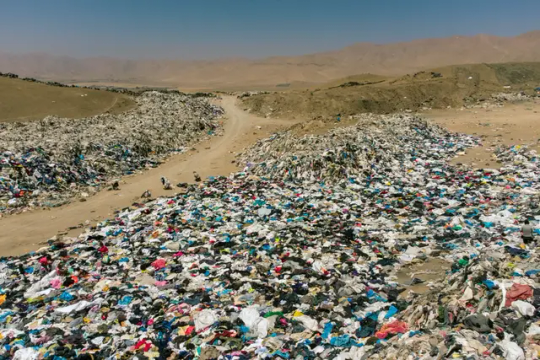
Atacama Desert, in Alto Hospicio, Iquique, Chile. (source)
The textile industry is destroying the world. The industry is wasting massive amounts of energy and materials, and polluting the air, the ground and the water supplies. It overwhelmingly exploits it's labour and extracts wealth from colonized countries, especially in Asia. I assume we all broadly understand this, but I think it's useful to have it all laid out in front of you to see the big picture, the core issues causing this destruction and find ways how to effectively move forward.
The concerning trend behind this ever-increasing devastation are shortening of trend cycles, lowering clothing prices and massive amount of wasted products. Still in year 2000 it was common for fashion brands to have two collections per year, while now e.g. Zara produces 24 collections and H&M produces 12-16 collections per year. Clothing prices have fallen (at leas in EU) 30% from 1996 to 2018 when adjusted to inflation, which has contributed to the 40% increase in clothing consumption per person between 1996 and 2012 (in EU). (source) As the revenue made by the clothing industry keep rising - from 2017 to 2021 they doubled (source) - falling prices can only be achieved with increasing worker exploitation and decreasing quality. I think the 36% degrees times clothing are used in average during the last 15 years (source) is a clear indication on the continuing drop in quality of clothing. Clothing production doubled between 2000 and 2015, while 30% of the clothes produced per year are never sold and are often burned instead (source), presumably to prevent the returns from falling due to oversupply.
These all factors are driving people to overconsume. While people in EU keep buying more clothes, they haven't used up to 50% of the clothes in their wardrobe for over a year (source). This overconsumption is only made much worse by the new type of hyper fast fashion companies like SHEIN and Temu, which are using addictive psychological tactics developed by social media companies (source 1, source 2). They are cranking up all those concerning trends I mentioned above.
Under the cut I will go through the statistics of the most significant effects of the industry on environment and people. I will warn you it will be bleak. This is not just a fast fashion problem, basically the whole industry is engaging in destructive practices leading to this damage. Clothing is one of those things that would be actually relatively easy to make without massive environmental and human cost, so while that makes the current state of the industry even more heinous, it also means there's hope and it's possible to fix things. In the end, I will be giving some suggestions for actions we could be doing right now to unfuck this mess.
Carbon emissions
The textile industry is responsible for roughly 10% of the global CO2 emissions, more than aviation and shipping industry combined. This is due to the massive supply chains and energy intensive production methods of fabrics. Most of it can be contributed to the fashion sector since around 60% of all the textile production is clothing. Polyester, a synthetic fiber made from oil which accounts for more than half of the fibers used in the textile industry, produces double the amount of carbon emissions than cotton, accounting for very large proportions of all the emissions by the industry. (source 1, source 2)
Worker exploitation
Majority of the textiles are produced in Asia. Some of the worst working conditions are in Bangladesh, one of the most important garment producers, and Pakistan. Here's an excerpt from EU Parliament's briefing document from 2014 after the catastrophic Rana Plaza disaster:
The customers of garment producers are most often global brands looking for low prices and tight production timeframes. They also make changes to product design, product volume, and production timeframes, and place last-minute orders without accepting increased costs or adjustments to delivery dates. The stresses of such policies usually fall on factory workers.
The wage exploitation is bleak. According to the 2015 documentary The True Cost less than 2% of all garment factory workers earned a living wage (source). Hourly wages are so low and the daily quotas so high, garment workers are often forced through conditions or threats and demand to work extra hours, which regularly leads to 10-12 hour work days (source) and at worst 16 hour workdays (source), often without days off. Sometimes factories won't compensate for extra hours, breaching regulations (source).
Long working hours, repetitive work, lack of breaks and high pressure leads to increased risks of injuries and accidents. Small and even major injuries are extremely common in the industry. A study in three factories in India found that 70% of the workers suffered from musculosceletal symptoms (source). Another qualitative study of female garment workers and factory doctors in Dhaka found that long hours led to eye strain, headaches, fatigue and weight loss in addition to muscular and back pains. According to the doctors interviewed, weight loss was common because the workers work such long hours without breaks, they didn't have enough time to eat properly. (source) Another study in 8 factories in India found that minor injuries were extremely common and caused by unergonomic work stations, poor organization in the work place and lack of safety gear, guidelines and training (source). Safety precautions too are often overlooked to cut corners, which periodically leads to factory accidents, like in 2023 lack of fire exists and fire extinguishers, and goods stacked beyond capacity led to a factory fire in Pakistan which injured dozens of workers (source) or like in 2022 dangerous factory site led to one dead worker and 9 injured workers (source).
Rana Plaza collapse in 2013 is the worst industrial accident in recent history. The factory building did not have proper permits and the factory owner blatantly ignored signs of danger (other businesses abandoned the building a day before the collapse), which led to deaths of 1 134 workers and injuries to 2 500 workers. The factory had or were at the time working for orders of at least Prada, Versace, Primark, Walmart, Zara, H&M, C&A, Mango, Benetton, the Children's Place, El Corte Inglés, Joe Fresh, Carrefour, Auchan, KiK, Loblaw, Bonmarche and Matalan. None of the brands were held legally accountable for the unsafe working conditions which they profited off of. Only 9 of the brands attended a meeting to agree on compensation for the victim's families. Walmart, Carrefour, Auchan, Mango and KiK refused to sight the agreement, it was only signed by Primark, Loblaw, Bonmarche and El Corte Ingles. The compension these companies provided was laughable though. Primemark demanded DNA evidence that they are relatives of one of the victims from these struggling families who had lost their often sole breadwinner for a meager sum of 200 USD (which doesn't even count for two months of living wage in Bangladesh (source)). This obviously proved to be extremely difficult for most families even though US government agreed to donate DNA kits. This is often said to be a turning point in working conditions in the industry, at least in Bangladesh, but while there's more oversight now, as we have seen, there's clearly still massive issues. (source 1, source 2)
One last major concern of working conditions in the industry I will mention is the Xinjiang raw cotton production, which is likely produced mainly with forced labour from Uighur concentration camps, aka slave labour of a suspected genocide. 90% of China's raw cotton production comes from Xinjiang (source). China is the second largest cotton producer in the world, after India, accounting 20% of the yearly global cotton production (source).
Pollution
Synthetic dyes, which synthetic fibers require, are the main cause of water pollution caused by the textile industry, which is estimated to account for 20% of global clean water pollution (source). This water pollution by the textile industry is suspected of causing a lot of health issues like digestive issues in the short term, and allergies, dermatitis, skin inflammation, tumors and human mutations in the long term. Toxins also effect fish and aquatic bacteria. Azo dyes, one of the major pollutants, can cause detrimental effects to aquatic ecosystems by decreasing photosynthetic activity of algae. Synthetic dyes and heavy metals also cause large amounts of soil pollution. Large amounts of heavy metals in soil, which occurs around factories that don't take proper environmental procautions, can cause anaemia, kidney failure, and cortical edoem in humans. That also causes changes in soil texture, decrease in soil microbial diversity and plant health, and changes in genetic structure of organisms growing in the soil. Textile factory waste water has been used for irrigation in Turkey, where other sources of water have been lacking, causing significant damage to the soil. (source)
Rayon produced through viscose process causes significant carbon disulphide and hydrogen sulphide pollution to the environment. CS2 causes cardiovascular, psychiatric, neuropsychological, endocrinal and reproductive disorders. Abortion rates among workers and their partners exposed to CS2 are reported to be significantly higher than in control groups. Many times higher amounts of sick days are reported for workers in spinning rooms of viscose fiber factories. China and India are largest producers of CS2 pollution, accounting respectively 65.74% and 11,11% of the global pollution, since they are also the major viscose producers. Emission of CS2 has increased significantly in India from 26.8 Gg in 2001 to 78.32 Gg in 2020. (source)
Waste
The textile industry is estimated to produce around 92 million tons of textile waste per year. As said before around 30% of the production is never sold and with shortening lifespans used the amount of used clothing that goes to waster is only increasing. This waste is large burned or thrown into landfills in poor countries. (source) H&M was accused in 2017 by investigative journalists of burning up to 12 tonnes of clothes per year themselves, including usable clothing, which they denied claiming they donated clothing they couldn't sell to charity instead (source). Most of the clothing donated to charity though is burned or dumbed to landfills (source).
Most of the waste clothing from rich countries like European countries, US, Australia and Canada are shipped to Chile (source) or African countries, mostly Ghana, but also Burkina Faso and Côte d'Ivoire (source). There's major second-hand fashion industries in these places, but most of the charity clothing is dumbed to landfills, because they are in such bad condition or the quality is too poor. Burning and filling landfills with synthetic fabrics with synthetic dyes causes major air, water and soil pollution. The second-hand clothing industry also suppresses any local clothing production as donated clothing is inherently more competitive than anything else, making these places economically reliant on dumbed clothing, which is destroying their environment and health, and prevents them from creating a more sustainable economy that would befit them more locally. This is not an accident, but required part of the clothing industry. Overproduction let's these companies tap on every new trend quickly, while not letting clothing the prices in rich countries drop so low it would hurt their profits. Production is cheaper than missing a trend.
Micro- and nanoplastics
There is massive amounts of micro- and nanoplastics in all of our environment. It's in our food, drinking water, even sea salt (source). Washing synthetic textiles accounts for roughly 35% of all microplastics released to the environment. It's estimated that it has caused 14 million tonnes of microplastics to accumulate into the bottom of the ocean. (source)
Microplastics build up into the intestines of animals (including humans), and have shown to probably cause cause DNA damage and altered organism behavior in aquatic fauna. Microplastics also contain a lot of the usual pollutants from textile industry like synthetic dyes and heavy metals, which absorb in higher quantities to tissues of animals through microplastics in the intestines. Studies have shown that the adverse effect are higher the longer the microplastics stay in the organism. The effects cause major risks to aquatic biodiversity. (source) The health effects of microplastics to humans are not well known, but studies have shown that they could have adverse effects on digestive, respiratory, endocrine, reproductive and immune systems. (source)
Microplastics degrade in the environment even further to nanoplastics. Nanoplastic being even smaller are found to enter blood circulation, get inside cells and cross the blood-brain barrier. In fishes they have been found to cause neurological damage. Nanoplastics are also in the air, and humans frequently breath them in. Study in office buildings found higher concentration of nanoplastics in indoor air than outdoor air. Inside the nanoplastics are likely caused mostly by synthetic household textiles, and outdoors mostly by car tires. (source) An association between nanoplastics and mitochondrial damage in human respiratory cells was found in a recent study. (source)
Micro and nano plastics are also extremely hard to remove from the environment, making it even more important that we reduce the amount of microplastics we produce as fast as possible.
What can we do?
This is a question that deserves it's own essays and articles written about it, but I will leave you with some action points. Reading about these very bleak realities can easily lead to overwhelming apathy, but we need to channel these horrors into actions. Whatever you do, do not fall into apathy. We don't have the luxury for that, we need to act. These are industry wide problems, that simply cannot be fixed by consumerism. Do not trust any clothing companies, even those who market themselves as ethical and responsible, always assume they are lying. Most of them are, even the so called "good ones". We need legislation. We cannot allow the industry to regulate itself, they will always take the easy way out and lie to their graves. I will for sure write more in dept about what we can do, but for now here's some actions to take, both political and individual ones.
Political actions
Let's start with political actions, since they will be the much more important ones. While we are trying to dismantle capitalism and neocolonialism (the roots of these issues), here's some things that we could do right now. These will be policies that we should be doing everywhere in the world, but especially rich countries, where most of the clothing consumption is taking place. Vote, speak to others, write to your representative, write opinion pieces to your local papers, engage with democracy.
Higher requirements of transparency. Right now product transparency in clothing is laughably low. In EU only the material make up and the origin country of the final product are required to be disclosed. Everything else is up to the company. Mandatory transparency is the only way we can force any positive changes in the production. The minimum of transparency should be: origin countries of the fibers and textiles in the product itself; mandatory reports of the lifecycle emissions; mandatory reports of whole chain of production. Right now the clothing companies make their chain of production intentionally complex, so they have plausible deniability when inevitably they are caught violating environmental or worker protection laws (source). They intentionally don't want to be able to track down their production chain. Forcing them to do so anyway would make it very expensive for them to keep up this unnecessarily complex production chain. These laws are most effective when put in place in large economies like EU or US.
Restrictions on the use of synthetic fibers. Honestly I think they should be banned entirely, since the amount of microplastics in our environment is already extremely distressing and the other environmental effects of synthetic fibers are also massive, but I know there are functions for which they are not easily replaced (though I think they can be replaces in those too, but that's a subject of another post), so we should start with restrictions. I'm not sure how they should be specifically made, I'm not a law expert, but they shouldn't be used in everyday textiles, where there are very easy and obvious other options.
Banning viscose. There are much better options for viscose method that don't cause massive health issues and environmental destruction where ever it's made, like Lyocell. There is absolutely no reason why viscose should be allowed to be sold anywhere.
Governmental support for local production by local businesses. Most of the issues could be much more easily solved and monitored if most clothing were not produced by massive global conglomerations, but rather by local businesses that produce locally. All clothing are made by hand, so centralizing production doesn't even give it advantage in effectiveness (only more profits for the few). Producing locally would make it much more easier to enforce regulations and it would reduce production chains, making production more effective, leaving more profits into the hands of the workers and reducing emissions from transportation. When the production is done by local businesses, the profits would stay in the producing country and they could be taxed and utilized to help the local communities. This would be helpful to do in both exploited and exploiter countries. When done in rich countries who exploit poorer ones, it would reduce the demand for exploitation. In poor countries this is not as easily done, since poor means they don't have money to give around, but maybe this could be a good cause to put some reparations from colonizers and global corporations, which they should pay.
Preventing strategic accounting between subsidiaries and parent companies. Corporate law is obviously not my area of expertise, but I know that allowing corporations to move around the accounting of profits and losses between subsidiaries and parent companies in roughly 1980s, was a major factor in creating this modern global capitalist system, where corporations can very easily manipulate their accounting to utilize tax heavens and avoid taxes where they actually operate, which is how they are upholding this terrible system and extracting the profits from the production countries. How specifically this would be done I can't tell because again I know shit about corporate law, so experts of that field should plan the specifics. Overall this would help deal with a lot of other problems than just the fashion industry. Again for it to be effective a large economic area like EU or US should do this.
Holding companies accountable for their whole chain of production. These companies should be dragged to court and made to answer for the crimes they are profiting of off. We should put fear back into them. This is possible. Victims of child slavery are already doing this for chocolate companies. If it's already not how law works everywhere, the laws should be changed so that the companies are responsible even if they didn't know, because it's their responsibility to find out and make sure they know. They should have been held accountable for the Rana Plaza disaster. Maybe they still could be. Sue the mother fuckers. They should be afraid of us.
Individual actions
I will stress that the previous section is much more important and that there's no need to feel guilty for individual actions. This is not the fault of the average consumer. Still we do need to change our relationship to fashion and consumption. While it's not our fault, one of the ways this system is perpetuated, is by the consumerist propaganda by fashion industry. And it is easier to change our own habits than to change the industry, even if our own habits have little impact. So these are quite easy things we all could do as we are trying to do bigger change to gain some sense of control and keep us from falling to apathy.
Consume less. Better consumption will not save us, since consumption itself is the problem. We consume too much clothing. Don't make impulse purchases. Consider carefully weather you actually need something or if you really really want it. Even only buying second-hand still fuels the industry, so while it's better than buying new, it's still better to not buy.
Take proper care of your clothing. Learn how to properly wash your clothing. There's a lot of internet resources for that. Never wash your wool textiles in washing machine, even if the textile's official instructions allow it. Instead air them regularly, rinse them in cool water if they still smell after airing and wash stains with water or small amount of (wool) detergent. Never use fabric softener! It damages the fabrics, prevents them from properly getting clean and is environmentally damaging. Instead use laundry vinegar for making textiles softer or removing bad smells. (You can easily make laundry vinegar yourself too from white vinegar and water (and essential oils, if you want to add a scent to it) which is much cheaper.) Learn how to take care of your leather products. Most leather can be kept in very good condition for a very long time by occasional waxing with beeswax.
Use the services of dressmakers and shoemakers. Take your broken clothing or clothing which doesn't fit anymore to your local dressmaker and ask them if they can do something about it. Take your broken and worn leather products to your local shoemaker too. Usually it doesn't cost much to get something fixed or refitted and these expert usually have ways to fix things you couldn't even think of. So even if the situation with your clothing or accessory seems desperate, still show it to the dressmaker or shoemaker.
If it's extremely cheap, don't buy it. Remember that every clothing is handmade. Only a small fraction of the cost of the clothing will be paying the wages of the person who made it with their hands. If a shirt costs 5 euros (c. 5,39 USD), it's sewer was only payed mere cents for sewing it. I'm not a quick sewer and it takes me roughly 1-2 hours to cut, prepare and sew a simple shirt, so I'm guessing it would take around half an hour to do all that for a factory worker on a crunch, at the very least 15 minutes. So the hourly pay would still be ridiculously low. However, as I said before, the fact that the workers in clothing factories get criminally low pay is not the fault of the consumer, so if you need a clothing item, and you don't have money to buy anything else than something very cheep, don't feel guilty. And anyway expensive clothing in no way necessarily means reasonable pay or ethical working conditions, cheep clothing just guarantee them.
Learn to recognize higher quality. In addition to exploitation, low price also means low quality, but again high price doesn't guarantee high quality. High quality allows you to buy less, so even if it's not as cheep as low quality, if you can afford it, when you need it, it will be cheaper in long run, and allows you to consume less. Check the materials. Natural fibers are your friends. Do not buy plastic, if it's possible to avoid. Avoid household textiles from synthetic fibers. Avoid textiles with small amounts of spandex to give it stretch, it will shorten the lifespan of the clothing significantly as the spandex quickly wears down and the clothing looses it's shape. Also avoid clothing with rubber bands. They also loose their elasticity very quickly. In some types of clothing (sport wear, underwear) these are basically impossible to avoid, but in many other cases it's entirely possible.
Buy from artisans and local producers, if you can. As said better consumption won't fix this, but supporting artisans and your local producers could help keep them afloat, which in small ways helps create an alternative to the exploitative global corporations. With artisans especially you know the money goes to the one who did the labour and buying locally means less middlemen to take their cut. More generally buy rather from businesses that are located to the same country where the production is, even if it's not local to you. A local business doesn't necessarily produce locally.
Develop your own taste. If you care about fashion and style, it's easy to fall victim to the fashion industry's marketing and trend cycles. That's why I think it's important to develop your personal sense of style and preferences. Pay attention at what type of clothes are comfortable to you. Go through your wardrobe and track for a while which clothing you use most and which least. Understanding your own preferences helps you avoid impulse buying.
Consider learning basics of sewing. Not everyone has the time or interest for this, but if you in anyway might have a bit of both, I suggest learning some very simple and basic mending and reattaching a button.
Further reading on this blog: How to see through the greenwashing propaganda of the fashion industry - Case study 1: Shein
Bibliography
Academic sources
An overview of the contribution of the textiles sector to climate change, 2022, L. F. Walter et al., Frontiers in Environmental Science
How common are aches and pains among garment factory workers? A work-related musculoskeletal disorder assessment study in three factories of south 24 Parganas district, West Bengal, 2021, Arkaprovo Pal et al., J Family Med Prim Care
Sewing shirts with injured fingers and tears: exploring the experience of female garment workers health problems in Bangladesh, 2019, Akhter, S., Rutherford, S. & Chu, C., BMC Int Health Hum Rights
Occupation Related Accidents in Selected Garment Industries in Bangalore City, 2006, Calvin, Sam & Joseph, Bobby, Indian Journal of Community Medicine
A Review on Textile and Clothing Industry Impacts on The Environment, 2022, Nur Farzanah Binti Norarmi et al., International Journal of Academic Research in Business and Social Sciences
Carbon disulphide and hydrogen sulphide emissions from viscose fibre manufacturing industry: A case study in India, 2022, Deepanjan Majumdar et al., Atmospheric Environment: X
Microplastics Pollution: A Brief Review of Its Source and Abundance in Different Aquatic Ecosystems, 2023, Asifa Ashrafy et al., Journal of Hazardous Materials Advances
Health Effects of Microplastic Exposures: Current Issues and Perspectives in South Korea, 2023, Yongjin Lee et al., Yonsei Medical Journal
Nanoplastics and Human Health: Hazard Identification and Biointerface, 2022, Hanpeng Lai, Xing Liu, and Man Qu, Nanomaterials
Other sources
The impact of textile production and waste on the environment (infographics), 2020, EU
Chile’s desert dumping ground for fast fashion leftovers, 2021, AlJazeera
Fashion - Worldwide, 2022 (updated 2024), Statista
Fashion Industry Waste Statistics & Facts 2023, James Evans, Sustainable Ninja (magazine)
Everything You Need to Know About Waste in the Fashion Industry, 2024, Solene Rauturier, Good on You (magazine)
Textiles and the environment, 2022, Nikolina Šajn, European Parliamentary Research Service
Help! I'm addicted to secondhand shopping apps, 2023, Alice Crossley, Cosmopolitan
Addictive, absurdly cheap and controversial: the rise of China’s Temu app, 2023, Helen Davidson, Guardian
Workers' conditions in the textile and clothing sector: just an Asian affair? - Issues at stake after the Rana Plaza tragedy, 2014, Enrico D'Ambrogio, European Parliamentary Research Service
State of The Industry: Lowest Wages to Living Wages, The Lowest Wage Challenge (Industry affiliated campaign)
Fast Fashion Getting Faster: A Look at the Unethical Labor Practices Sustaining a Growing Industry, 2021, Emma Ross, International Law and Policy Brief (George Washington University Law School)
Dozens injured in Pakistan garment factory collapse and fire, 2023, Hannah Abdulla, Just Style (news media)
India: Multiple factory accidents raise concerns over health & safety in the garment industry, campaigners call for freedom of association in factories to ‘stave off’ accidents, 2022, Jasmin Malik Chua, Business & Human Rights Resource Center
Minimum Wage Level for Garment Workers in the World, 2020, Sheng Lu, FASH455 Global Apparel & Textile Trade and Sourcing (University of Delaware)
Rana Plaza collapse, Wikipedia
Buyers’ compensation for Rana Plaza victims far from reality, 2013, Ibrahim Hossain Ovi, Dhaka Tribune (news media)
World cotton production statistics, updated 2024, The World Counts
Dead white man’s clothes, 2021, Linton Besser, ABC News
#fashion#fashion industry#sustainability#sustainable fashion#sustainable clothing#environment#climate change#i will be continuing the series of how to see through fashion industry propaganda at some point#i just felt compelled to write this because i feel like people so often miss the forest for the trees in this conversation
505 notes
·
View notes
Text
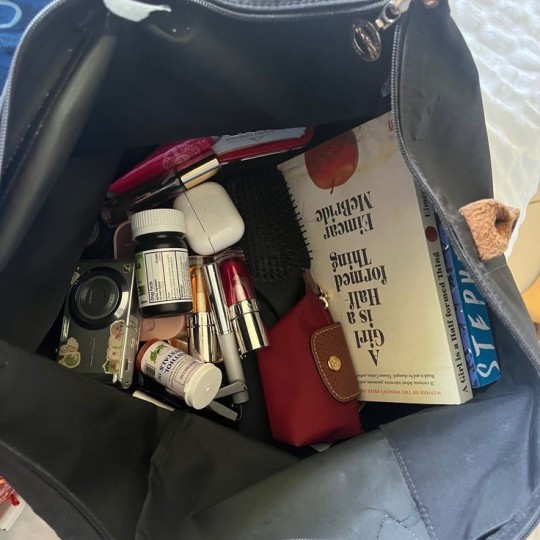
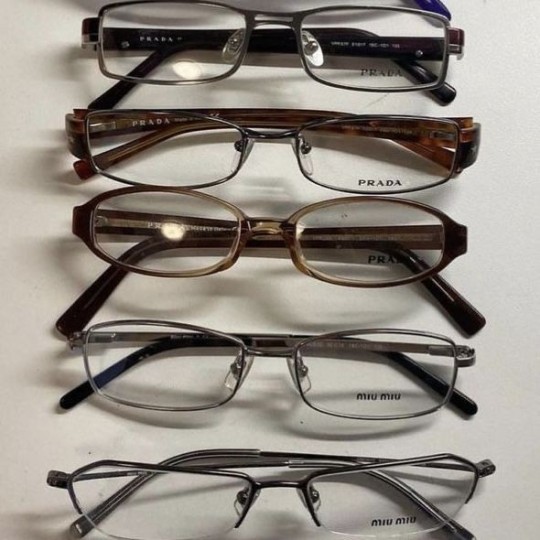
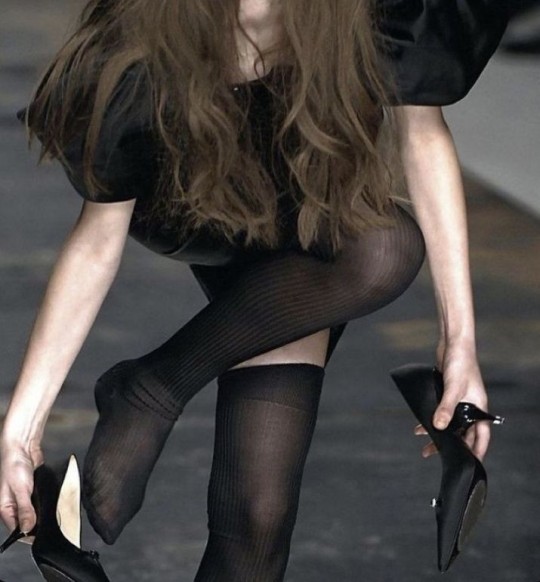


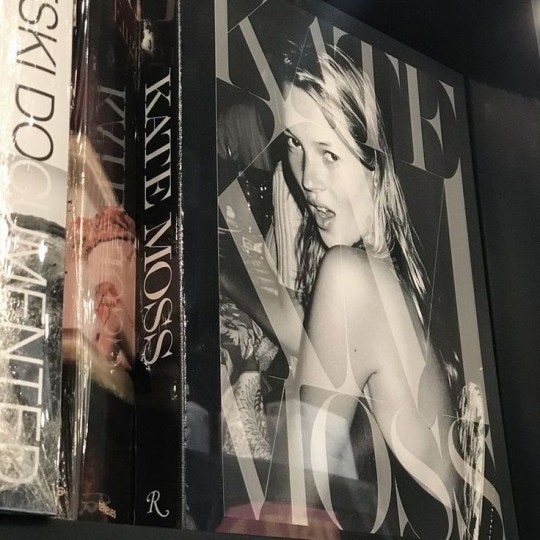
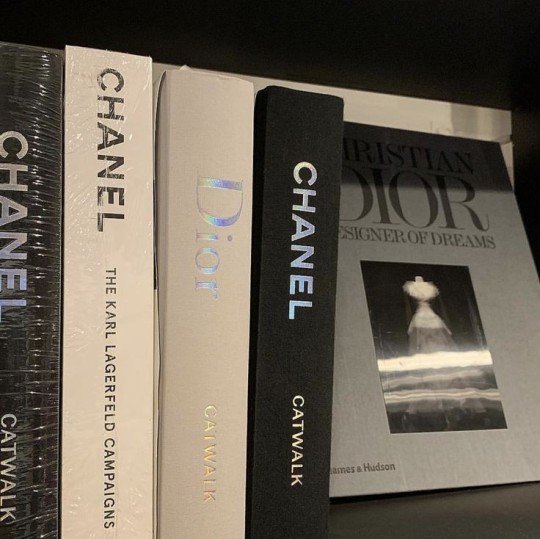

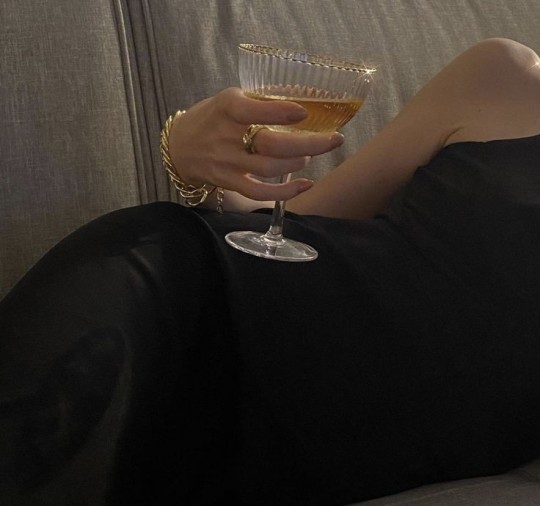
⋆.ೃ࿔*:・ . . . that's all .
#femcel#girlblogging#feminine#girl blogger#pinterest#tumblr girls#im just a girl#this is what makes us girls#female manipulator#female rage#hell is a teenage girl#fashion#the devil wears prada#miranda priestly#fashion industry#fashion inspo#fashion icon#it girl#vouge#vougemagazine#christian dior#prada#nyc girl#paris girl#france#nyc#2000s nostalgia
327 notes
·
View notes
Text

Stripes
#stripes#striped dress#dresses#cute dress#toya's tales#style#toyastales#toyas tales#fashion#clothing#fashion photography#fashion inspiration#fashion trends#trendy#viral trends#trending#trends#beautiful women#asian woman#asian#fashion inspo#fashion industry#fashion details#fashion dress#fashion design
114 notes
·
View notes
Text
"Nasir Mansoor has spent 40 years fighting for Pakistan’s workers. Whether demanding compensation on behalf of the hundreds of people who died in a devastating 2012 factory fire in Karachi or demonstrating against Pakistani suppliers to global fashion brands violating minimum wage rules, he’s battled many of the country’s widespread labor injustices.
Yet so far, little has improved, said Mansoor, who heads Pakistan’s National Trade Union Federation in Karachi... Regulations and trade protocols look good on paper, but they rarely trickle down to the factory level. “Nobody cares,” Mansoor said. “Not the government who makes commitments, not the brands, and not the suppliers. The workers are suffering.”
Change on the Horizon
But change might finally be on the horizon after Germany’s new Supply Chain Act came into force last year. As Europe’s largest economy and importer of clothing, Germany now requires certain companies to put risk-management systems in place to prevent, minimize, and eliminate human rights violations for workers across their entire global value chains. Signed into law by German Chancellor Olaf Scholz in January 2023, the law covers issues such as forced labor, union-busting, and inadequate wages, for the first time giving legal power to protections that were previously based on voluntary commitments. Companies that violate the rules face fines of up to 8 million euros ($8.7 million)...
...As governments come to realize that a purely voluntary regimen produces limited results, there is now a growing global movement to ensure that companies are legally required to protect the people working at all stages of their supply chains.
The German law is just the latest example of these new due diligence rules—and it’s the one with the highest impact, given the size of the country’s market. A number of other Western countries have also adopted similar legislation in recent years, including France and Norway. A landmark European Union law that would mandate all member states to implement similar regulation is in the final stages of being greenlighted.
Although the United States has legislation to prevent forced labor in its global supply chains, such as the 2021 Uyghur Forced Labor Prevention Act, there are no federal laws that protect workers in other countries from abuses that fall short of forced labor. That said, a proposed New York state bill, the Fashion Act, would legally require most major U.S. and international brands to identify, prevent, and remediate human rights violations in their supply chain if passed, with noncompliance subject to fines. Since major fashion brands could hardly avoid selling their products in New York, the law would effectively put the United States on a similar legal level as Germany and France...
The Results So Far
As of January, Germany’s new law applies to any company with at least 1,000 employees in the country, which covers many of the world’s best-known fast fashion retailers, such as Zara and Primark. Since last January [Jan 2023], German authorities say they have received 71 complaints or notices of violations and conducted 650 of their own assessments, including evaluating companies’ risk management.
In Pakistan, the very existence of the German law was enough to spark action. Last year, Mansoor and other union representatives reached out to fashion brands that sourced some of their clothing in Pakistan to raise concerns about severe labor violations in garment factories. Just four months later, he and his colleagues found themselves in face-to-face meetings with several of those brands—a first in his 40-year career. “This is a big achievement,” he said. “Otherwise, [the brands] never sit with us. Even when the workers died in the factory fire, the brand never sat with us.” ...
-via The Fuller Project, April 2, 2024. Article headers added by me.
Article continues below, with more action-based results, including one factory that "complied, agreeing to respect minimum wages and provide contract letters, training on labor laws, and—for the first time—worker bonuses"
With the help of Mansoor and Zehra Khan, the general secretary of the Home-Based Women Workers Federation, interviews with more than 350 garment workers revealed the severity of long-known issues.
Nearly all workers interviewed were paid less than a living wage, which was 67,200 Pakistan rupees (roughly $243) per month in 2022, according to the Asia Floor Wage Alliance. Nearly 30 percent were even paid below the legal minimum wage of 25,000 Pakistani rupees per month (roughly $90) for unskilled workers. Almost 100 percent had not been given a written employment contract, while more than three-quarters were either not registered with the social security system—a legal requirement—or didn’t know if they were.
When Mansoor, Khan, and some of the organizations raised the violations with seven global fashion brands implicated, they were pleasantly surprised. One German retailer reacted swiftly, asking its supplier where the violations had occurred to sign a 14-point memorandum of understanding to address the issues. (We’re unable to name the companies involved because negotiations are ongoing.) The factory complied, agreeing to respect minimum wages and provide contract letters, training on labor laws, and—for the first time—worker bonuses.
In February [2024], the factory registered an additional 400 workers with the social security system (up from roughly 100) and will continue to enroll more, according to Khan. “That is a huge number for us,” she said.
It’s had a knock-on effect, too. Four of the German brand’s other Pakistani suppliers are also willing to sign the memorandum, Khan noted, which could impact another 2,000 workers or so. “The law is opening up space for [the unions] to negotiate, to be heard, and to be taken seriously,” said Miriam Saage-Maass, the legal director at ECCHR.
Looking Forward with the EU
...Last month [in March 2024], EU member states finally approved a due diligence directive after long delays, during which the original draft was watered down. As it moves to the next stage—a vote in the European Parliament—before taking effect, critics argue that the rules are now too diluted and cover too few companies to be truly effective. Still, the fact that the EU is acting at all has been described as an important moment, and unionists such as Mansoor and Khan wait thousands of miles away with bated breath for the final outcome.
Solidarity from Europe is important, Khan said, and could change the lives of Pakistan’s workers. “The eyes and the ears of the people are looking to [the brands],” Mansoor said. “And they are being made accountable for their mistakes.”"
-via The Fuller Project, April 2, 2024. Article headers added by me.
#pakistan#fashion#fashion industry#fast fashion#labor#labor unions#labor rights#unions#workers rights#capitalism#european union#germany#united states#new york#garment industry#garment manufacturing#supply chain#good news#hope
213 notes
·
View notes
Text
Honestly, knowing things about sewing and clothing construction is sometimes a curse I wish I wasn't suffering from.
So my textile hobby is embroidery. Right now, I am embroidering a shirt as a gift for a friend. For the shirt, I just needed something simple, plain, and pink - so I went to Target, because that was what was available to me, and somewhere I was pretty sure would have what I was looking for. It did, and I got a plain pink t-shirt for a not-bad price.
Here I am, a week later and almost done with my project, when I randomly glance down at the hem and feel my heart sink into my feet.
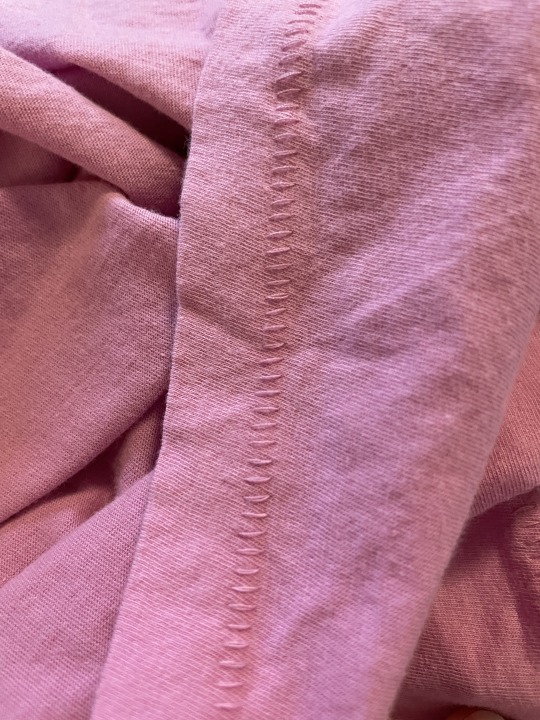
because what. the Fuck. is This???
This is one of the worst hems I have ever seen on a commercial garment in my entire life. If a single one of those threads gets cut, the whole bottom of the shirt is unraveling faster than the life of a college student who only just now realized their final was supposed to be a semester-long project. This is the kind of thing I would expect to see for someone who had to hand sew the hem, because I've rarely ever seen vertical hemming outside of handmade clothes. And looking at the inside, I was even more confused.
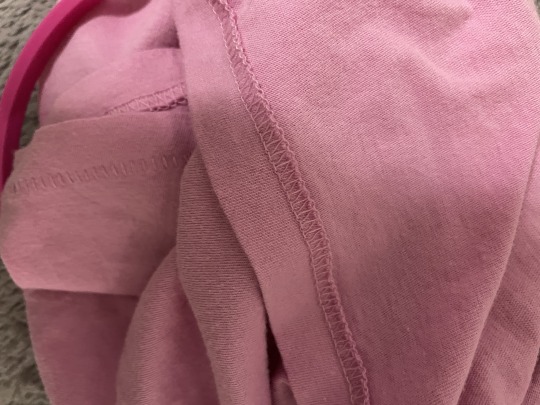
Because the inside looks normal? So what the hell happened to the outside?? This appears to be a vertical hemming stitch with a ladder back, which I have never seen before in my entire life.
Let's look at two other examples for comparison.
First, we have a normal cotton t-shirt from a few years ago:
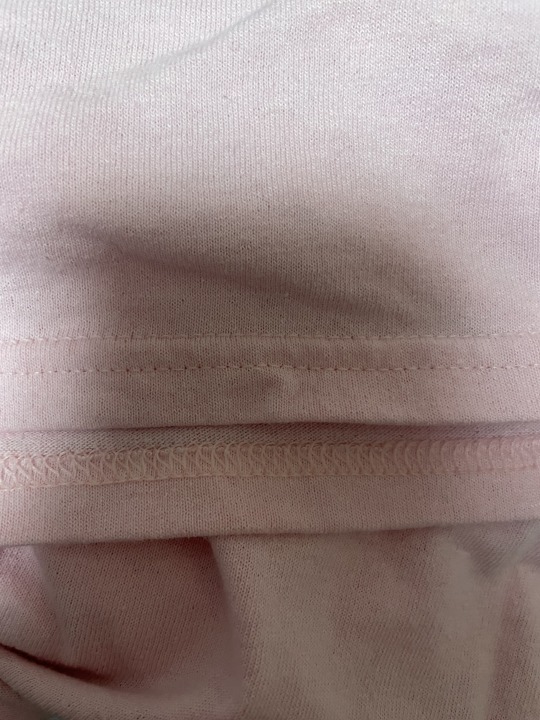
This is a 2 needle flat lock stitch (6mm), the type of stitch I would expect to see. You might be able to snag the inside thread on something, but it wouldn't unravel the whole thing, and you'd have to take some seam rippers to get at the outside in any meaningful way.
Now let's look at something older:

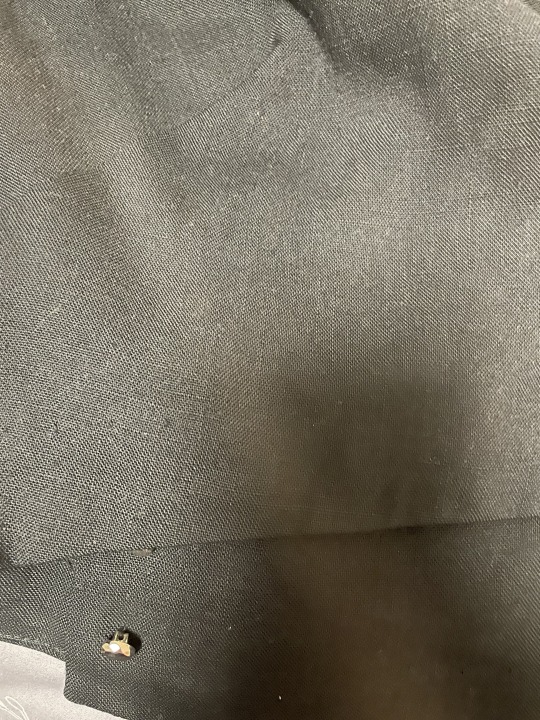
This is the inside and outside of a vintage 50s top I bought about a year ago. Notice that there's no visible hem on the outside at all. The bottom is folded up into the inside, where one or two other layers of fabric are located in order to stitch it together. There's a row of single-needle lock stitching close to the bottom of the garment, with another single-needle row and a line of overlocked stitching just to top it all off. The only way this could be more secure is if it attended therapy and achieved self-actualization. This hem isn't going anywhere.
So where does this leave us? Well, it personally leaves me very upset about the state of the clothing industry. Yes, these tops all came at various price points, and have different levels of quality accordingly, but consumers should be able to buy clothes that won't immediately fall apart on them should a stiff breeze happed to blow past. If I had the time or the machinery, I would fix the hem myself, but I don't, and I am genuinely upset to have put hours upon hours of work onto a project with such a shitty canvas. And frankly, a little insulted.
Moral of the story: Check your seams people. You'll thank me when tugging on a single thread doesn't get you arrested for public indecency.
#textiles#textile art#embroidery#clothes#clothing#fashion industry#clothing industry#clothing contrusction#vintage clothing#vintage#modern clothing#fiber arts#fiber crafts#text post#nerd rant about hems#crafts#crafting#sewing
46 notes
·
View notes
Text
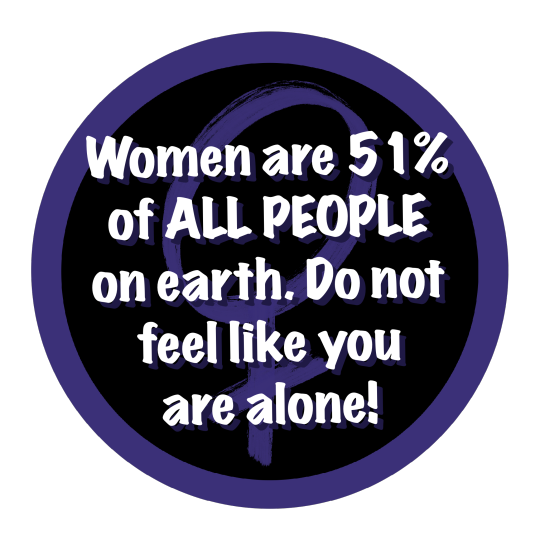



I am no artist, but I made some pretend buttons or stickers in the color scheme similar to the Lesbian Labrys flag, but with a cooler toned purple out of respect. Anyone is free to use them however they please, so long as there is no hate speech involved.
Feminism is the answer to female liberation. Gender abolishment has been at the root of feminist theory since it’s conception, as it places men and women in categoric boxes and should no longer be a necessary social construct in modern day society. Men and women should not be defined by society’s opinion of what “masculinity” and “femininity” is as if should they not fulfill those requirements, they do not qualify. You are worth more than fulfilling your societies conceptions of being. You are and your spirit is valued beyond how well you are perceived by others. You deserve healthcare and safety under legislation. No child should be kicked out of their homes for being gender-non-conforming. We are all people, regardless of sex.
#Feminism#original post#gender roles#gender abolition#sex based oppression#Patriarchy#beauty standards#fashion industry#anti capitalism#art
324 notes
·
View notes
Text
Glass and mirrors

pairing: young!coriolanussnow x fem!reader summary: There is one thing the world needs to know about her: she didn't become a star overnight. She was born to be one. warnings: canon-typical violence, mentions of mental illness, narcissism, blonde men who need therapy, unhinged women, people in shitty relationships and toxic industries word count: 4.6k PART TWO IS HERE
author's note: Hello and welcome to our small community of people who have fallen victim to the charming (and evil) blonde man! This fic is heavily inspired by the edits of models that pop up on my ticktock feed every day. Shout out to them and the talented editors who bless my eyes with their creations. As for YN this time, prepare to be on quite a ride because she, surprise-surprise, is evil! In my head, there has to be at least one victor who feels no remorse at all; they can't all be morally good (and relatively sane) people. Also, the obsession with beauty in this fic is, in fact, intentional, so bear with me. Feel free to comment or insult the author in the comments, but only if you are creative with it. Enjoy and see you in part 2!
In all of her short childhood, she always loved mirrors. Her grandma used to joke about it with her old friends while they shared lunch at the factory: ''That empty-headed child wants to do nothing but stare at herself all day.'' The women would laugh, their raspy voices making the glid, already filled with toxic fumes to the brim, hotter. YN didn't mind; she would pretend not to hear them, clinging to the machinery in front of her instead. She would get out of here sooner or later, and she'd see whose laughter would be left echoing all through the narrow streets.
She wasn't born to rot in this place like these people were; YN was sure of that. Not with a face like hers, with manners she taught herself from the bright magic box in their cramped commune apartment, where a few times a year the government played the show. It was supposed to be a punishment, YN reminded herself each time, but it didn't look like one. She watched the children eat more food than she had seen in a month and then cry on the stage in front of millions. She wouldn't cry if she was there, that was for certain. People die every day here, but none of them get to dress up in the jewels provided by the wealthiest people she has ever seen.
It was funny how they had all the money in the world and still chose to dress so horribly. Mismatched fabrics and smudged colours on their faces, like the colours of the lake near her house—the factories polluted it with dyes, turning the water green, purple, and sometimes even pink. That's how she got her old grey dress to be such a pretty lavender colour. It didn't matter that everyone at school laughed at her, even Miss Kyla; she was horrendously ugly anyway, her hair resembling the colour of unwashed underwear. YN wore her dress with pride, mimicking the voice of the funny multicolour-haired man on the screen, chatting with long o's and a's.
That's how she ended up here, on the first floor of the newly renovated training centre, with a drink in her freshly manicured hand. She had two hours before her stylists would need her again—a time designated for sleep, which she apparently so greatly lacks. YN doesn't care; she went without sleep for much longer than two days. Instead, she does what she loves the most—turns on a shiny screen and watches the golden letters appear: the 15th Annual Hunger Games.
It starts with reaping, as always, but YN skips that part—she doesn't like seeing herself in those dirty rags, although, as papers would later state, ''nothing could make this girl ugly, even if a potato sack was put on her body.'' She likes interviews better. Luckily, the wait is not very long; soon enough, her favourite host pops up, his hair shimmering with sea green.
''And now, our dear viewers, I am more than pleased to announce our next tribute from District 1—please let her hear how excited we are to meet her!'' His voice booms through the theatre as the crowd erupts into applause.
YN moves gracefully, a beaming smile on her face matching that of a host. Her gloved hands wave at the supposed people in front of her as if they were guests at her birthday party. But most importantly, dress. The one she chose herself, arguing over it with her stylist for the last few hours, the one that fitted her perfectly. Capitol enough to appeal to the audience, district enough to highlight that she isn't one of them—she is something new, undiscovered, and worth keeping an eye on. It's almost not a dress at all—the sparkling, sheer fabric of beautiful white, with stars gathering at her chest and bottom to finish the ''almost naked'' look. And the crowd goes crazy for it. People shout, and the splashes of the cameras blinding her create a new melody that is so unfamiliar to YN's ears. Admiration. The thing she craved for so long.
''Alright, alright,'' Lucky Flickerman smiles, gesturing for the crowd to settle down. ''We don't want to scare her off now, do we?'' He turns to her, a microphone in hand. ''What's your name, sweetheart?''
''YN Y/L/N. And I am afraid you can't scare me off, no matter how hard you try. The thing is, I am here to stay,'' she jokes, cocking an eyebrow at the man beside her.
''Oh, how I love your confidence! Now tell me—we heard you are a volunteer—the first in the history of District 1! Are there any special ties to the girl who was supposed to stand here tonight, or what's going on?''
''Well, I was dying to see you in person, of course—no pun intended.''
Oh, there weren't any ties to the girl, or the boy, for that matter. No, YN simply wanted to go at her peak chance of winning—countless years of secret preparation in the factory; working a night shift after school and full days of weekends; hours of studying every plant and animal known to mankind—all to ensure that she wouldn't waste her chance like most kids here did.
''That's an honour coming from your lips; we are happy to see you in the Capitol, Miss Y/L/N. Since you came here by choice, what strategy are you planning on using in the arena? Maybe something tied to your district's craft?''
''If you promise to keep this between us, I'll confess—I will use my charms to make everyone fall in love with me and watch them fight by promising the winner a kiss—and then I will take it from there.'' YN turns to face the lights, staring directly into the camera for a few seconds. The crowd laughs once more, some going so far as to cheer and whistle in excitement. ''But in all honesty, I think I have a fair shot—I would win in a day if it meant the unlimited supply of those amazing cupcakes with sprinkles on top.''
''Well, in that case, you should definitely get a good rest this night—you are not the only one who got your eye on them! Ladies and gentlemen, prepare for the Cupcake Games tomorrow, and don't forget to sponsor this lovely girl right here if you want to see her win! And now, a short word from our sponsors.''
Cupcake jokes are still funny to her, even after two years, although she got sick of them a week after her victory and was just as sick of all the titles papers came up with to fit her into the candy girl box. It served her well, for which she is grateful; the sponsors did send her a shitton of things, although mostly useless.
Next is the introduction of everyone else; YN doesn't care to look at it for more than just a few seconds, speeding it up to maximum. It's boring to no end—how do Capitolees watch it every year with such excitement? She stops to look only when her face appears on the screen, covered in crimson blood.
She counted six canons when she finally stopped to take a breath in and look at her surroundings. That was about right, although YN didn't count how many times she pulled a knife out of somebody's still-warm body and lurched into another nearby. The sand soaked up the blood fast, she noticed, stepping over the pile of what used to be her competitors and walking towards the cone-shaped something. Nobody in sight—each one of the ''better'' kids is now dead without a chance to kill each other, to kill her, and ''others'' will die like flies under the hot sun of what looked like a desert. YN noticed that some even left behind the given jackets; she collected them before stepping into the Cornucopia, claiming them as her own. Not everyone grew up in hot factories, she thought to herself, so they have no chance of knowing how cold it gets at night.
YN doesn't like how the uniform looks on her; the T-shirt hangs around her frame too loosely. It's evident that she didn't eat enough back then, but it was tolerable. The dried blood looked worse; with her stoic face and eye colour, the streams looked too grotesque, almost unserious; it didn't fit the look she was going for. Her hands itch to wipe it before YN remembers that it's non-existent now—the girl on the screen is just a recording. She forwards a little more, looking for the commentary of the first night from the hosts—their excitement and praise never get old—but hears knocking at her door just as she is about to press play. YN glances at the clock—it's too early for the prep team, so it must be someone else—and turns off the TV just to be sure she heard it right.
When the knocking continues, she shouts a quick ''Come in,'' after checking her reflection on the now dark screen. ''Ah, Maggie!''
''How many times do I have to repeat that my name is Mags, not Maggie? Not Mags with fangs either, to be clear. Just Mags.''
''But everyone calls you that! And I want to be special,'' YN whines, laying back on the sofa.
It's Mags. YN likes Mags. Mags is the only girl besides her on the victors' list. Mags is the one who is always down to eat lunch together or to watch the new collection in the magazines. She is funny and down to earth, and, most importantly, Mags doesn't take bullshit from anyone.
''Even more special?'' Mags smiles, opening the fridge to look for something edible. There isn't much; they both know that YN would never eat something to ruin her figure. ''I saw your photoshoot on the street today. It's beautiful.''
''Thank you,'' YN smiles. She doesn't remember which one of her campaigns was supposed to air today, but it doesn't matter. ''Are you here for the promo again?''
The curly-haired woman nods, not looking up from the shelves. ''I hate it. I wish they would just leave me alone, so I can go home and forget about all of this.''
YN is always weirded out by such comments from Victor from 4 but never says anything. Not everyone was born to be in front of the camera; if that were the case, her talent wouldn't be so special anymore. ''It's our job, Maggie. They'll never leave us alone.''
''I know.'' Mags sighed, planting her body on the sofa beside her.
They are different, but YN thinks it's better that way. They are the same age, both 20, and that's about the only thing that ties them together. YN watches as her friend's chest rises and falls as she stares at the ceiling, her long, curly hair in some type of twist. YN would never style it like that, but Mags doesn't ask, so she stares at her in silence, trying her hardest not to compare them. She knows what type of conclusion will sparkle in her brain, but she doesn't want to admit it. Mags is her friend, her only good friend, so something inside YN fights hard to leave her alone. It's an unusual feeling, almost foreign, but YN wants to make an exception. She thinks Maggie deserves it.
''Are you okay?'' the woman asks her, finally snapping out of her trance. ''You are less talkative than usual.''
''Oh, yeah—just a little tired from work, that's it.''
Work. It's not the type of work people can really get tired from, and if anybody thinks otherwise, they never worked a day in District 1. Sometimes, YN can still feel the burning cloud of steam hitting her face when she closes her eyes. The work she does in Capitol is child's play—photoshoots, interviews, promotional campaigns, and runways. She is the only one with this kind of hectic schedule, the only one who is interesting enough for the general public to want to see her everywhere they go. Multiple shows a day wasn't uncommon; photoshoots until five a.m. were basically her usual routine; she did so many of them that she never remembered the brand name for more than an hour.
''Well, I hope I don't interrupt your me-time,'' Mags notes. ''Panem knows you need it. ''
''You worry too much about me. Better tell me about how life is in 4—anything new?''
There is probably nothing exciting, but it feels nice to listen to somebody talk with such love for their home as Mags does. It's also a great opportunity. YN catches every subtle expression and every movement of her friend with attentive eyes, making sure to parrot them later. She noticed from the recording today that her speech misses a certain effortlessness.
-
Curl and twist, curl and twist—YN has learned the pattern by now, sitting in front of the gigantic mirror, surrounded by a team of stylists. Hair, make-up, nails, and toes—five people work hand in hand for her to appear for two minutes on the long podium. The backstage is loud, and a lot is going on—last-minute changes, alterations, and quick touch-ups. YN doesn't bother to look around; she closes today like a face of the collection, and after she is done with this podium, the day is finally coming to an end.
''Oh, YN, darling, here you are!'' The bald man in his forties appears on the horizon of her peripheral vision, clasping his unnaturally white hands together. ''How are you doing, my little star? Anything you need?''
She is irritated to no end; her team booked seven shows for her today; she hadn't had anything to eat in the past six hours; and the loud music makes her head throb. But she doesn't voice any of that—nobody really wants to know how she is feeling.
Just like she guessed, the man doesn't wait for her response. ''There have been some changes in the order today, sweetheart. Jenovia will be closing today, and you will walk in her dress instead,'' the man says, turning to face her styling team. ''Change the hair to fit, and take off the blue in her make-up—it won't match. Good luck!''
''Do what he says,'' YN announces, her mouth twitching just a little. She is furious. To have that blonde bitch Jenovia walk in the best dress of the collection YN inspired? Over her dead body. Or, should she say, over Jenovia's? She will figure it out but do so later. Now there are only four girls before her, so she needs to be ready.
''Three, two, one! Go, go!'' the stage coordinator shouts, opening the curtain for her.
Right and left, hip and hand, followed by the strong clicking of her five-inch heels. The music is even louder here, with the beets vibrating through the runway and pouring into her bloodstream. She doesn't pay any attention to the glass floor underneath her. Surprisingly, her training before games helped her model more than one could guess. YN doesn't see anyone but the blinding lights lining the podium—not that she needs to see the hungry faces of the spectators. It doesn't matter what piece of fabric covers her body; they are looking at who wears it. Final pose at the centre—no smile is her go-to. Hold and turn is the golden rule.
''Here you are!'' One of the seamstresses grabs her hand, pulling her into a small, curtained space with countless clothes on racks. ''Calio wants you to hold a purse for the backstage photo and lose the belt. Where the fuck is the golden belt?'' she shouts, searching for one. ''Wait here; I'll go find it,'' she finally announces, running away before YN has the chance to suggest anything.
YN looks around, carefully moving the laying rags with her foot. She mentally goes over the outfits labelled with names, rating them one by one, until her eyes stop on the white dress. The closing dress, the one she was supposed to model. Underneath it are velvety black high boots.
The idea comes to her mind quickly: she steals a needle from the nearby table and carefully places it inside the shoes, making sure it looks like an accident.
''Finally,'' the woman returns with a belt in her hands, oblivious to YN's half-smile. ''Put it on and go; they are already waiting.''
''Of course, thanks.''
YN isn't sure how much time has passed before she hears a scream, standing up from her place in the corner with a blanket around her exposed shoulders. Surely enough, Jenovia is on the floor, crying crocodile tears—a needle inside her heel deep enough to make a few of the girls around her gag.
''What the fuck happened?'' It's Calio, the boss here; he was ordering her around before.
''I don't know,'' all the blonde girl can manage before bursting into tears one more time.
''Well, can you walk?'' he asks, kneeling to take a look.
''No,'' Jenovia whispers, her hand holding her bloodied foot.
The bald man sighed, more annoyed than concerned. ''We need a replacement. You,'' he points at YN. ''Take it off and change into the dress. Quick!''
YN does what she is told in no time; she doesn't want to wait until Jenovia suddenly gets better or the man finds a better-suited girl to close. After a few minutes, she is almost ready; she only needs the lipstick to finish it off.
''We don't have time!'' the man roars, dragging her to the exit. ''Here!'' He puffs out her hair and adjusts the layers of fake pearls covering her neck. ''Three, two, one! Go, fucking go!''
And go she does. A few steps on the runway, and she discovers that lipstick is still in her hands. YN puts it in the pocket of the enormously large black coat that hides the gorgeous white dress underneath. Step after step, her long black boots draw patterns on the glass. She will have no choice but to buy them; YN doesn't care if it's stupid. They helped her, so she will have them.
It's time for the final pose: YN takes out the lipstick from her pocket and applies it with two swift motions, blowing a kiss to the camera. It will definitely be a hit with the photographers. YN throws one last look before turning around and returning to the curtained exit. On her way back, when the lights lower to follow her back, she can see a little clearer. In the sea of vibrant hair colours and clothes, the platinum-blonde hair and a simple black suit stood out too much not to notice. There is only one person who could afford to look so simple—YN knows it. An opportunity of a lifetime.
She makes another stop in the middle of the podium, right in front of his seat. The coat slides off her shoulders effortlessly, and YN catches it just when the fabric is about to hit the floor. The crowd goes crazy, clapping and whistling at her tricks, but YN has no wish to entertain them any further. YN pauses for a moment, her eyes meeting icy-blue ones, before turning away and finishing the show. There is one thing the world needs to know about her: she didn't become a star overnight. She was born to be one.
-
Since the last show, she has done fifteen more—day after day, opening and closing. Her little trick got her where she wanted to be, with more money than one person could need in a lifetime and nowhere to spend it. Even now, standing in the long hallway of the training centre, she wears nothing she bought herself; all are gifted, sent, or handed by the adoring fans. Like a rag doll, with no say in how she looks or what she does, YN hears everyone say that it was ''a price of fame''. She doesn't think so; she was told what to do long before she tasted real butter on her toast.
The sliding door to her apartment moves almost without noise. While most victors complain that the lock system reminds them of prison, YN is grateful to have it. The thought of some crazy fanatic waiting for her in the dark isn't the most pleasant one. The designer bag finds its place on the floor, soon joined by the coat—room service will clean it up later. The heels slide off her feet quickly, leaving bloodied marks on her skin, but YN doesn't care enough to do something about them.
''Forgive me for joining you without an invitation.''
YN turns around, her hands grabbing the keys in her hands tighter. She mentally goes over her means of escape or fight—a mirror could easily be broken and used as a weapon; if necessary, she could also grab a nearby ottoman. The man in the chair doesn't look too impressed with her thought process. His lips curve into a smile, blue eyes staring at her with undivided attention. A suit, not very different from the one he wore at her show, was a deep brown colour.
''Mister President,'' YN breathes out, lowering her hand.
Coriolanus Snow. Light, almost white hair frames his face like a halo, with his suit hugging his waist just enough to highlight the broad shoulders. YN saw him on TV a couple of times, but seeing him in person was something entirely different. It's like the air shifts around him and changes with his presence.
''I believe we met before,'' he humours her, his eyes shining with mischief.
The light knocking on the door doesn't leave YN any time to answer. She presses a button near it, fixing her hair before opening it. YN tries to look as composed as possible without betraying her nerves—why was he here? ''Yes?''
''The dinner, Ma'am.'' the room service declares, pushing a cart in front of her.
YN nods, even though she didn't order one. ''Leave it here,'' she says, gesturing to the place nearby. When the door closes and she is alone with the man in her room again, her heart skips a beat.
''I took the liberty of ordering; I hope you don't mind.''
Even if she did, she knew better than to say anything. Instead, YN watched as the man stood up and took the dishes from the cart, placing them on the coffee table, before turning to her once more.
''Please, have a seat.''
She does what she is told, sitting down on her king-sized bed—the chair is already taken by him—and waits for the blonde man to start speaking. He doesn't right away, choosing to pour a glass of wine for her and himself.
YN watches the dark liquor pour into the glass, swirling with each drop. She isn't hungry—she rarely was—and the soup he ordered looks more like vomit than a dish, but she still takes the spoon and carefully places it into her mouth. Her lipstick stains the silverware with colour, leaving a small circle right at the end—that's when the man finally decides to speak.
''Dare I say I am a huge fan of your work ethic? Everyone who I've spoken to is very satisfied with your,'' he pauses, searching for the fitting word, ''dedication .''
''Thank you, Mister President,'' YN replies with a polite smile before returning to her soup. She watches him only from the corner of her eye. The way he cuts his steak with his ringed fingers and the way he places a small bite in his mouth before his lips close. There is a subtle roughness in his movements, a power play of some sort.
He catches her gaze and, for a moment, is silent. ''You probably wonder why I am here in the first place, outside of the amazing steak they cook here, of course. The thing is, Miss Y/L/N, that you are popular not only with the general public but with people higher in power as well. One may even say they fell in love with the way you present yourself.''
''I am pleased to know that, Mr. President, but I am only doing my job as a victor.''
''Then you will understand the weight of my dilemma. Those people who have served Panem all their lives faithfully usually don't ask for much recognition; they work because they want to build a better future for all of us. So, when they do ask for a small favour or two, I am more than happy to satisfy them. But recently, all they ask for is you .''
''I believe I don't quite understand. They want to meet me?''
''You can phrase it like that, yes. For a night or two, of course, with all expenses covered.''
It's heavy, the understanding of what Mister President really implies. The thought of someone's hand roaming her body brings her dinner up YN's throat. ''Why?'' Her voice is shakier than she would like, but she is more focused on composing the rising anger than noticing it.
''I am sorry, Miss Y/L/N, but I am afraid there is nothing I can do; I am greatly outnumbered. Unless,'' he starts but doesn't finish his sentence.
''Unless what?''
''Unless you are seen with me.''
His piercing blue eyes look at her, but there is nothing in them. Her chances are limited, and he knows it. There is something rogue in him beneath the veil of chivalry he offers. YN smiles at him. That's what this whole charade was about—he wants her. Coriolanus Snow, the most powerful man in the whole world, wants her.
''Of course, Mr. President. That's very generous of you.''
''Mister President is too official, don't you think, Miss Y/L/N? Perhaps we could find a more informal way of addressing each other?''
''Informal?'' YN asks, tilting her head to the side. If he wants her, he'll get her. ''What about Mister Snow?'' The buttons on her shirt are easy to manage—a few quick motions, and it slides off her shoulders onto the cream cover. ''Or, Sir Coriolanus?'' The pants are a little trickier, but YN learned that backstage, every second counts, so they soon also pool around her heels, the fabric hitting the floor with a slight thud.
The blonde man watches her intently, his eyes following every move of her hands. His legs are still spread wide on the lime-green chair as he slightly leans back. YN can't tell if he is enjoying her antics or not, but frankly, she doesn't care; she is enjoying it. The way her shadow dances on the wall, the way the air shifts in the huge room, transforming it into a tiny stage. YN looks at him with mischief, with superiority, even. After all, she is the show here. Why not let Mr. Savior think it is for him?
''Come, Mister Snow,'' she says, throwing it in his face like a bone to the dog.
He doesn't have the haste to join her; on the contrary, he stands up painfully slowly. His tall figure almost seems to stretch as he raises, covering the floor lamp behind him fully. When he finally circles the table to stand above her, his presence is overwhelming. YN lets him stand between her legs, his unusually cold hand on her thigh.
''I prefer Coriolanus,'' he whispers in her ear, lowering himself enough to touch her ear with his velvety lips. He pulls away slightly, planting a kiss on her cheek instead. ''Have a most pleasant night, Miss Y/L/N.''
And then he walks away. YN watches as his figure disappears behind the sliding door before she lets out a breath she didn't realize she was holding. Her gaze instinctively finds her reflection in the nearby mirror; there is no reason to shine if no one watches her.
#coriolanus x reader#imagine#corio snow#coriolanus snow#coriolanus snow fanfiction#coriolanus snow imagine#coriolanus snow x reader#character x you#the ballad of songbirds and snakes#hunger games x reader#the hunger games#fashion industry#president snow#tbosas#tbosas x reader#character x y/n#mags flanagan#mags#district four#district one#panem#capitol
164 notes
·
View notes
Text
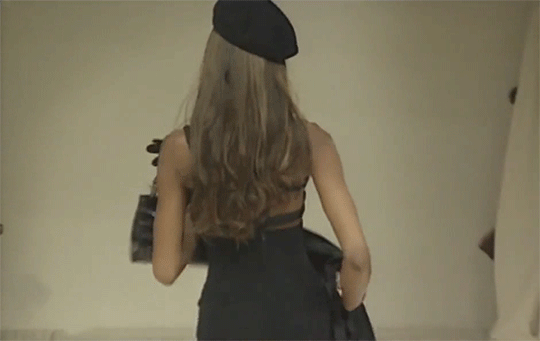
#͏͏ ͏͏ ͏͏ ͏͏ ͏͏ ͏͏ ͏͏ ͏͏ ͏͏ ͏͏ ͏͏ ͏͏ ͏͏ ͏͏ ͏͏ ͏͏ ͏͏ ͏͏ ͏͏ ͏͏ ͏͏ ͏͏ ͏͏ ͏͏ ͏͏ ͏͏ ͏ ͏͏ ͏͏ ͏͏ ͏͏ ͏͏ ͏͏ ͏͏ ͏͏ ͏͏ ͏͏ ͏͏ ͏͏ ͏͏ ͏͏#naomi campbell#90s aesthetic#90s supermodels#90s fashion#90s#fashion backstage#fashion industry#chaotic mannequin#just girly thoughts#girlhood#just girly posts#just girly things#girlblogger#it girl#gaslight gatekeep girlboss#divine feminine#female manipulator#gaslight girlboss gatekeep#hell is a teenage girl#girl blog#manic pixie dream girl#coquette girl#girlblogging#girlblog#girl boss gaslight gatekeep#girl interupted syndrome#just girls being girls#pinterest girl#this is what makes us girls
596 notes
·
View notes
Text
The blandification of fashion is very real, guys. It has been virtually impossible to find inspiring content for the past 2-3 seasons and I blame it on the rise of quiet luxury and late stage capitalism. The latter means that the fashion industry is designing as simply as possible (minimalism does not equal boring) not because of 'sustainability' as some people seem to put it, but to save on material, details. patterns, etc to increase profits in order not to go bankrupt in a system that demands increasing economic growth. The demand for quiet luxury has been welcomed by the fashion industry for this very same reason, but in my opinion, people who wear this 'trend' do not like fashion, since wearing nondescript clothing has nothing to do with style and individuality, but on the contrary: it makes you a clone. It has also nothing to do with minimalism and less with sustainability, because it is a logical fallacy to believe that absolute simplicity has a positive environmental impact, neither do the socalled 'capsule wardrobes'. You can buy a sequin skirt or something with a pattern or a very distinctive design, but if you wear it all the time, it is far more sustainable than a Loro Piana cashmere sweater you think you 'invested in', yet never wear. Capsule wardrobes and basics are a myth, as you will wear in real life what sparks joy in you the most (I'd rather wear my asymmetric tops than any 'basic' white shirt), not what a brand/influencer/magazine tells you to buy. Capsule wardrobes are a very individual thing based on your personality, not a cookie cutter formula. To achieve a wardrobe that you love and wear for years is a very organic and eventual process, definitely not based on what a Vogue site tells you to buy now, but on what you find yourself and love.
#blandification of fashion#fashion industry#quiet luxury#capsule wardrobe#myths#minimalism#fashion#style#trends#simple fashion#boring fashion
50 notes
·
View notes
Text


The Neon Demon (2016)
#the neon demon#surreal horror#horror#horror film#dark aesthetic#fashion model#horror aesthetic#creepy#nicolas winding refn#elle fanning#fashion industry#fashion#modeling#cw blood#tw blood#high fashion#supermodel aesthetic#narcissism#glamour#2010s
72 notes
·
View notes
Text
Okay, this might just be my sleep-deprived rambling but we NEED more Aoyama and Bakugo interaction in the MHA fandom. Like, Bakugo's parents are literally rich fashion industry gurus. Aoyama is a walking fashion icon doused in glitter.
Just imagine one day in the dorms Aoyama is walking around with a new outfit, some more lowkey designer brand, and Bakugo just stops, scans him up and down, and begrudgingly compliments the designer with some too-smart comment about the choice of hem stitching. Aoyama is FLOORED. The rest of 1-A? SHOCK.
#mha aoyama#yuga aoyama#glitter#designer#clothing#fashion#real Regina George mixed with Legally Blond moment#bakugou katsuki#mha bakugou#bnha bakugou#katsuki bakugo mha#class 1a#fashion industry#fashion icon#mha#fannon#bnha#my hero academia#the only things that calm bakugo are food and fashion#aoyama is a glitter bomb#if you put him in front of a fan a gust of glitter will suffocate everyone in the room#you're welcome
24 notes
·
View notes